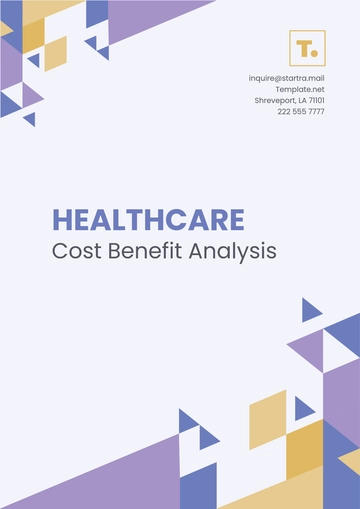Free Travel Agency Financial Analysis

1. Executive Summary
[Your Company Name] has undergone a thorough financial and market analysis to understand its current standing and future prospects within the travel industry. Key findings indicate a stable financial position with the potential for significant growth in emerging travel markets such as eco-tourism and luxury travel experiences. Recommendations focus on leveraging technology to enhance customer experience and operational efficiency, expanding into new market segments, and enhancing financial health through strategic partnerships and cost management.
2. Company Overview
[Your Company Name], founded in [Year], operates as a full-service travel agency providing a range of services including travel bookings, accommodation arrangements, packaged tours, and customized travel experiences. With a primary physical presence in major cities coupled with a robust online platform, [Your Company Name] caters to both leisure and business travelers, offering personalized services and 24/7 customer support.
3. Industry Analysis
The travel industry represents a large and constantly evolving sector, marked by swift advancements in technology and shifts in consumer tastes. Present trends within this sector show an increasing preference for customized travel experiences tailored to individual needs, alongside a heightened awareness and adoption of sustainable tourism practices that aim to minimize environmental impacts. Additionally, there is a significant trend towards the integration of digital technology in various aspects of travel planning and management, enhancing the efficiency and accessibility of travel-related services.
SWOT Analysis
Strengths | Weaknesses | Opportunities | Threats |
|---|---|---|---|
Established brand | High operational costs | Rising eco-tourism | Economic downturns |
Diverse services | Limited global reach | Technological advances | Intense competition |
4. Market Analysis
Demographics and Target Market
Primary: Affluent individuals aged 30-55 looking for luxury and bespoke travel experiences.
Secondary: Corporations that are in search of managed travel services to support their business operations.
Consumer Behavior Trends
Increased preference for flexible, customizable travel options.
The higher value placed on experiences over material goods influences travel decisions.
Market Segmentation
Luxury Travelers: High spenders looking for exclusive experiences.
Adventure Travelers: Seek unique and adventurous activities.
Business Travelers: Require efficient and comprehensive travel arrangements.
5. Financial Statements Analysis
The financial health of [Your Company Name] is thoroughly assessed through its key financial statements: the Profit and Loss Statement, Balance Sheet, and Cash Flow Statement for the fiscal year.
Profit and Loss Statement (FY 20xx)
Description | Amount (USD) |
|---|---|
Total Revenue | 5,000,000 |
Cost of Sales | 3,500,000 |
Gross Profit | 1,500,000 |
Operating Expenses | 800,000 |
Net Profit | 700,000 |
Balance Sheet
Assets | Amount (USD) |
|---|---|
Cash and Equivalents | 200,000 |
Receivables | 300,000 |
Total Assets | 2,000,000 |
Liabilities | Amount (USD) |
|---|---|
Short-term Debt | 150,000 |
Long-term Debt | 500,000 |
Total Liabilities | 650,000 |
Cash Flow Statement
Activity | Amount (USD) |
|---|---|
Operating Cash Flow | 450,000 |
Investing Cash Flow | -100,000 |
Financing Cash Flow | 250,000 |
Net Increase in Cash | 600,000 |
The detailed examination of these statements offers an extensive and thorough perspective on the financial stability of the company, highlighting its capability to maintain ongoing operations, invest in growth opportunities, and handle its liabilities in an efficient manner.
6. Financial Ratios and Metrics Analysis
Key Financial Ratios (FY 20xx)
Ratio | Value |
|---|---|
Gross Margin | 30% |
Net Margin | 14% |
Return on Assets | 35% |
Current Ratio | 1.75 |
Quick Ratio | 1.40 |
The financial ratios from the table provide a snapshot of the company's fiscal health:
Gross Margin (30%): Indicates the percentage of total sales revenue that the company retains after incurring the direct costs associated with producing the goods and services it sells.
Net Margin (14%): This ratio shows what percentage of sales has turned into profits, illustrating bottom-line profitability after all expenses.
Return on Assets (35%): Demonstrates how effective the company is at using its assets to generate earnings.
Current Ratio (1.75): This liquidity ratio indicates the company's ability to pay short-term obligations or those due within one year.
Quick Ratio (1.40): Also known as the acid-test ratio, it measures the ability to meet short-term obligations with its most liquid assets.
7. Operational Performance
[Your Company Name] implements a comprehensive and diverse operational strategy designed to optimize both efficiency and customer satisfaction. Detailed performance metrics indicate that the company effectively manages its operational costs. Furthermore, [Your Company Name] invests strategically in both technology and staff training, initiatives that significantly improve the quality of service delivery. The main revenue stream breakdown is as follows:
Packaged Tours (40% of revenue): Curated travel experiences that offer convenience and value.
Custom Itineraries (30% of revenue): Tailored travel planning for clients seeking unique experiences.
Corporate Contracts (30% of revenue): Comprehensive travel services for business clients.
The agency has achieved a reduction in customer acquisition costs by 20% through effective online marketing strategies and optimizing referral networks. This not only reduces the overhead costs but also increases profitability by retaining a higher percentage of revenue. Further, lifecycle value analysis of customers suggests significant repeat business, indicating strong customer satisfaction and loyalty.
8. Risk Analysis
Financial Risks
Currency Fluctuations: As a global operator, currency risks are mitigated through the use of forward contracts and by offering multi-currency pricing.
Payment Defaults: Risk is reduced by requiring deposits and offering travel insurance.
Operational Risks
Supplier Reliability: Establishing and maintaining robust relationships with a variety of suppliers around the world is essential to guarantee the continuity of service.
Technological Disruptions: Continued financial commitments towards enhancing information technology security and establishing multiple system backups serve as a robust defense against potential operational disruptions.
Market Risks
Economic Downturns: A diversified service offering helps cushion against downturns in any single travel segment.
Regulation Changes: Staying abreast of regulatory changes through active memberships in travel industry associations and adjusting business practices accordingly.
9. Forecasting and Future Projections
Based on current trends and strategic initiatives, [Your Company Name] anticipates a compounded annual growth rate (CAGR) of 10% over the next five years. Financial forecasts are supported by:
Expansion into Asian and Middle Eastern luxury travel markets.
Investment in mobile technology to enhance booking and customer service platforms.
Introduction of sustainable travel packages to attract eco-conscious travelers.
Scenario Analysis
Best Case: Accelerated growth due to a surge in global travel post-pandemic.
Expected Case: Steady growth as forecasted.
Worst Case: Slower growth due to potential global economic challenges.
10. Investment and Funding Analysis
Recent investment endeavors have concentrated on improving and expanding technological capabilities, which are essential for sustaining a competitive edge in the marketplace. Future funding goals include:
Seeking $5 million in venture capital to expand digital marketing efforts and develop an AI-based travel recommendation system.
Exploring government grants for small businesses to support expansion into eco-friendly travel services.
11. Regulatory and Environmental Factors
Regulatory compliance is crucial, especially in sectors that involve data protection, such as adhering to the General Data Protection Regulation (GDPR) for customers based in Europe and maintaining travel safety standards. Environmental considerations include:
Reducing carbon footprint by promoting flights with airlines committed to carbon neutrality.
Promoting accommodations and transportation options that are environmentally friendly in travel packages.
12. Conclusion and Strategic Recommendations
In order to maintain and strengthen its leadership role within the travel industry, it is recommended that [Your Company Name] persistently concentrate on pursuing technological innovations, expanding into new markets, and enhancing operational efficiency. Recommendations include:
Deepening engagement with existing customers through loyalty programs and personalized travel experiences.
Expanding service offerings in high-growth markets such as adventure and wellness tourism.
Strengthening resilience against market volatilities through diversification and strategic partnerships.
- 100% Customizable, free editor
- Access 1 Million+ Templates, photo’s & graphics
- Download or share as a template
- Click and replace photos, graphics, text, backgrounds
- Resize, crop, AI write & more
- Access advanced editor
Enhance your financial oversight with Template.net's Travel Agency Financial Analysis Template. This fully customizable and editable tool, powered by our AI Editor Tool, allows you to assess financial performance meticulously. Ideal for spotting trends, planning budgets, and making informed decisions to drive your travel agency’s success. An essential asset for financial management.





























